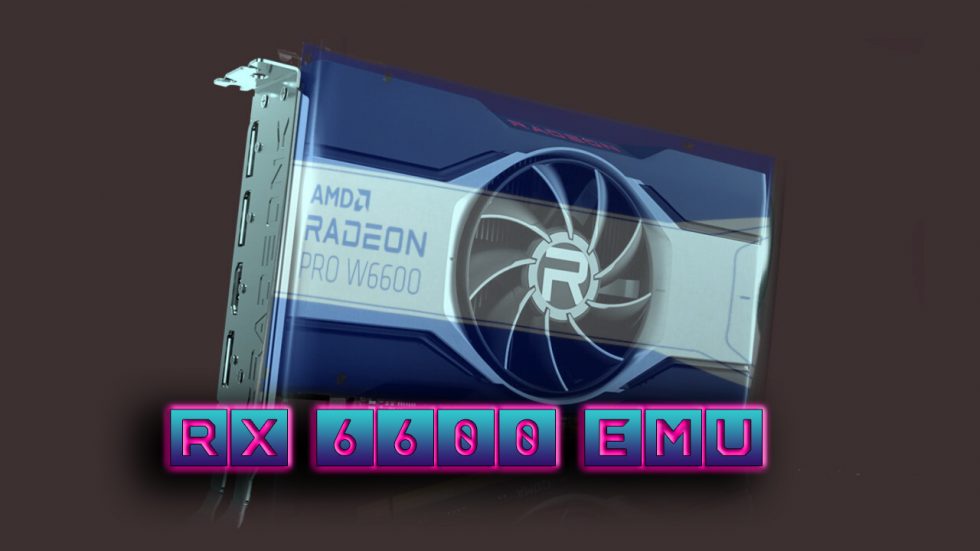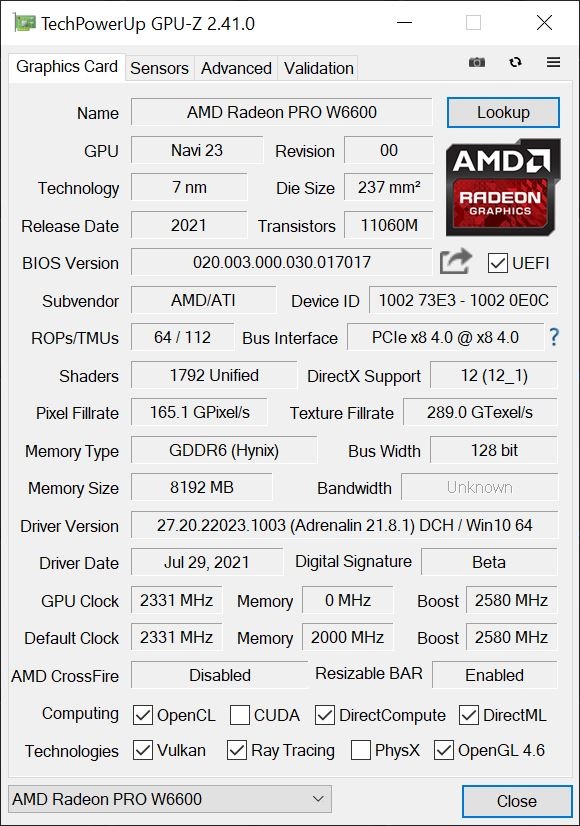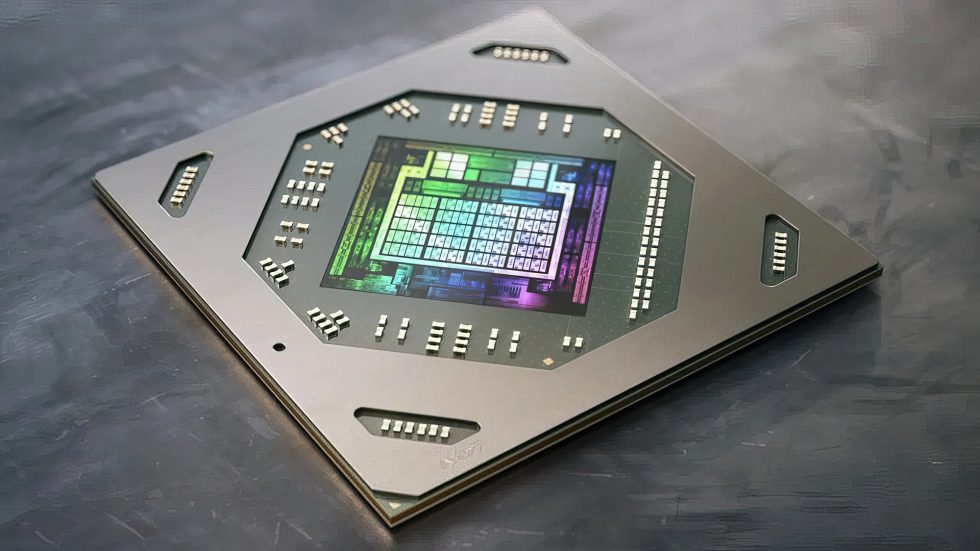The card hasn’t been officially launched yet, but the chip does exist, so I can offer exclusive benchmarks today. Because the already sold Radeon Pro W6600 relies on the same chip and so you can convert this card into a fictitious board card with some factory OC in a few steps. Because the workstation graphics card has the same genes, but has been trimmed a bit for efficiency. This in turn can be easily undone with suitable tools for memory clock and power limit and you quickly get what officially does not exist yet.

With the Radeon RX 6600 emulated today, AMD could round off the Navi portfolio further downwards, because there would still be room for Navi23 XL instead of XT. And then what about the prices? AMD is talking about an MSRP (MSRP) of $379 for the Radeon RX 6600 XT basic board cards, while the MSRP of the NVIDIA GeForce RTX 3060 was $329 at the time. In order to be attractive, the card would probably have to be placed at a little under 300 Euros, but in relation to the RX 6600XT, it would then again rather be 319 to 329 Euros in relation to the performance. After all, the GeForce RTX is still there.
But over 300 Euros for a graphics card that you’d rather only bench in Full-HD so that frame rates remain playable at all and which, like its big sister, also suffers from the trimmed bus with only 8 lanes, are the product of an insane market, whose profiteers this time aren’t directly in the production or the chip forges. Of course, these players are not starving, but the reasons for the inflated prices are rooted in the nature of the human soul or in its deep, black abysses. Therefore, I will leave the price out of the following tests. There’s nothing you can do about it at the moment anyway.
We build ourselves a Radeon RX 6600
The AMD Radeon RX 6600 Non-XT relies on the Navi 23 XL GPU, which only has 28 instead of 32 compute units or 1792 instead of 2048 stream processors. Thus, the card is already at a disadvantage of about 12 percentage points on paper, if the clock is set at the same level. The card also features, like the XT, 32MB of Infinity Cache and 8GB of GDDR6 memory running over a 128-bit wide bus interface. The Navi 23 XL GPU itself measures 237 mm² and consists of 11.06 billion transistors. However, the GPU is still not the smallest chip in the RDNA 2 family, as Navi 24 is still expected here for the absolute entry-level range.
The memory speed will surely be back at the usual 16 Gbps, which will then give a total bandwidth of 256 GB/s. The Radeon Pro W6600, on the other hand, only uses 14 Gbps modules from Hynix with 1750 MHz (instead of the usual 2000 MHz), so I had to help out a bit here for the first time. But the memory definitely allows that too, always provided you cool everything better. This is then the second point where I just permanently connected the fan to 12 volts.
The MSI Radeon RX 6600 XT Gaming X 8 GB tested at launch reached a peak of just over 2610 MHz, the extra cooled Radeon Pro W6600 managed about 20-50 MHz less in practice. However, this can be more than compensated for by raising the power limit, so that both cards ended up clocking at about the same rate when they were fully warmed up. The emulated “Radeon RX 6600” naturally leaves the sweet spot with this, but it still remains more frugal than its big sister despite everything.
But this is exactly the weakness of my current emulation, because it is not possible to estimate how far AMD could use salvage later to get as many chips as possible still executable. If the partially deactivated chips are worse than the ones used on the Radeon Pro W6600, you might have to add another 10 watts to the power consumption. But we’ll have to wait and see. At least we see already today, of one then perhaps with an undervolted cards still would get there.
The screenshot from GPU-Z gives information about the remaining data of the card (RAM OC already included), whereby GPU-Z shows the frequency of the GPU clock incorrectly for the memory. The error also occurs with the non-tweaked card, in which case 1750 MHz is there. But no matter, because it was going on.

Again, I have a table for all statisticians among you, before it really gets going from the next page on.
| Model | RX 6600 EMU |
RX 6600 XT (MSI) | RX 6700 XT | RX 6800 | RX 6800 XT | RX 6900 XT |
|---|---|---|---|---|---|---|
| GPU | Navi 23 | Navi 23 | Navi 22 | Navi 21 | Navi 21 | Navi 21 |
| Process node | 7 nm | 7 nm | 7 nm | 7 nm | 7 nm | 7 nm |
| The Size | 237 mm2 | 237 mm2 | 336 mm2 | 520 mm2 | 520 mm2 | 520 mm2 |
| Transistors |
11.06 billion | 11.06 billion | 17.2 billion | 26.8 billion | 26.8 billion | 26.8 billion |
| Compute units | 28 | 32 | 40 | 60 | 72 | 80 |
| Shader | 1792 | 2048 | 2560 | 3840 | 4608 | 5120 |
| TMUs/ROPs | 112 / 64 | 128/64 | 160/64 | 240 / 96 | 288 / 128 | 320 / 128 |
| Game clock | 2331 MHz | 2428 MHz | 2424 MHz | 1815 MHz | 2015 MHz | 2015 MHz |
| Boost Clock | > 2600 MHz* | > 2600 MHz* | 2581 MHz | 2105 MHz | 2250 MHz | 2250 MHz |
| Memory GDDR6 |
8 GB | 8 GB | 12 GB | 16 GB | 16 GB | 16 GB |
| Infinity cache | 32 MB | 32 MB | 96 MB | 128 MB | 128 MB | 128 MB |
| Memory bus | 128-bit | 128-bit | 192-bit | 256-bit | 256-bit | 256-bit |
| Memory clock | 16 Gbps | 16 Gbps | 16 Gbps | 16 Gbps | 16 Gbps | 16 Gbps |
| Bandwidth | 256 GB/s | 256 GB/s | 384 GB/s | 512 GB/s | 512 GB/s | 512 GB/s |
| TDP | 130 W | 160 W | 230 W | 250 W | 300 W | 300 W |
*) Boost Clock measured in games
- 1 - Einführung und Technische Daten
- 2 - Testsystem und Methodik
- 3 - Gaming Performance Full-HD
- 4 - FPS-Verläufe als Kurven pro Karte und Spiel
- 5 - Kurven der Percentile pro Karte und Spiel
- 6 - Frame Time Kurven pro Karte und Spiel
- 7 - Frame Time Balkengrafiken pro Karte und Spiel
- 8 - Varianzen pro Karte und Spiel
- 9 - Leistungsaufnahme pro Karte und Spiel
- 10 - Leistungsaufnahme CPU pro Karte und Spiel
- 11 - Effizienz pro Karte und Spiel
- 12 - Kumulation, Zusammenfassung und Fazit

































14 Antworten
Kommentar
Lade neue Kommentare
Urgestein
Mitglied
Veteran
Veteran
Veteran
Moderator
Mitglied
Urgestein
Mitglied
Mitglied
Veteran
Urgestein
Urgestein
Urgestein
Alle Kommentare lesen unter igor´sLAB Community →